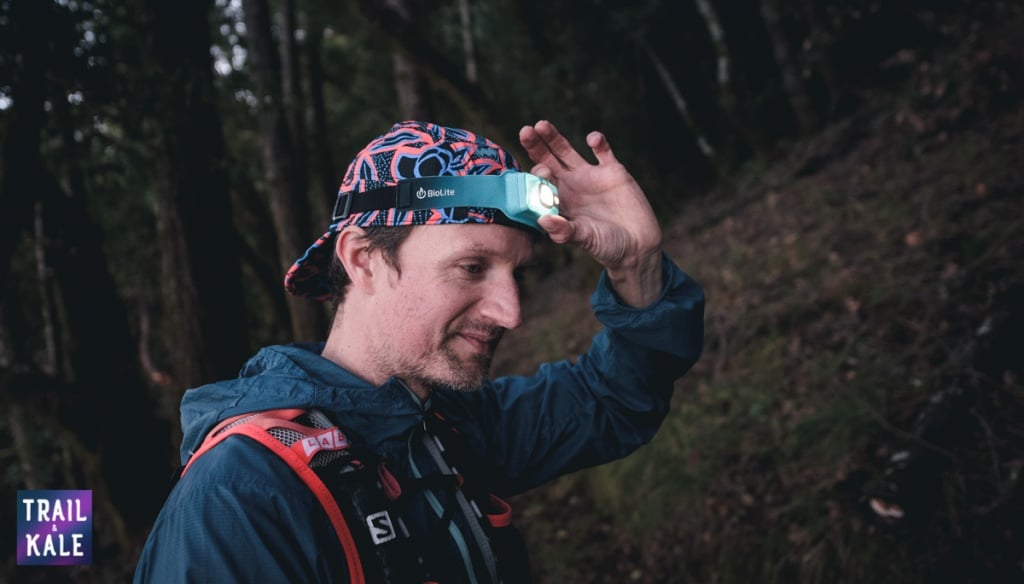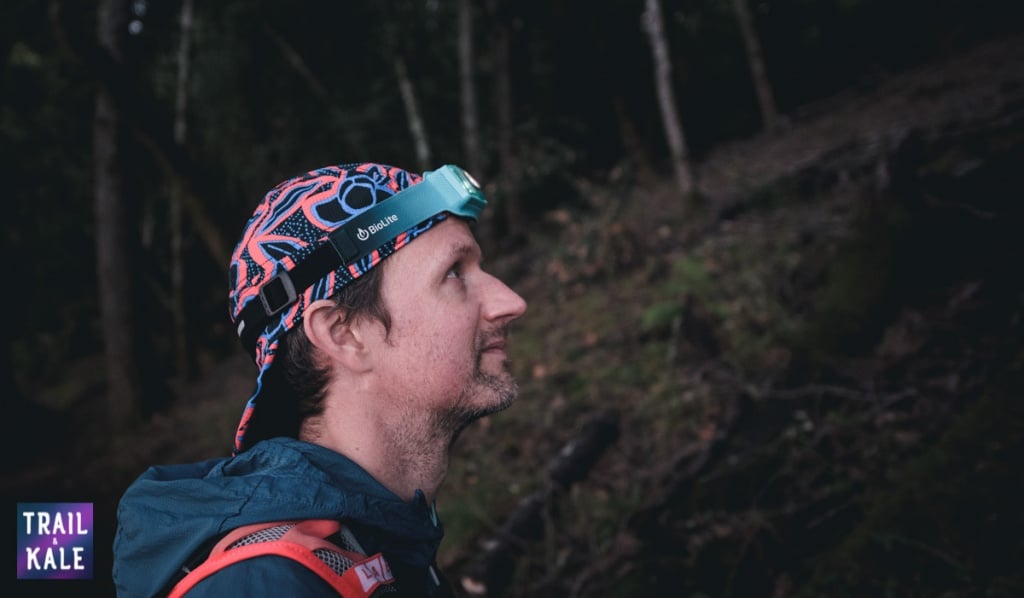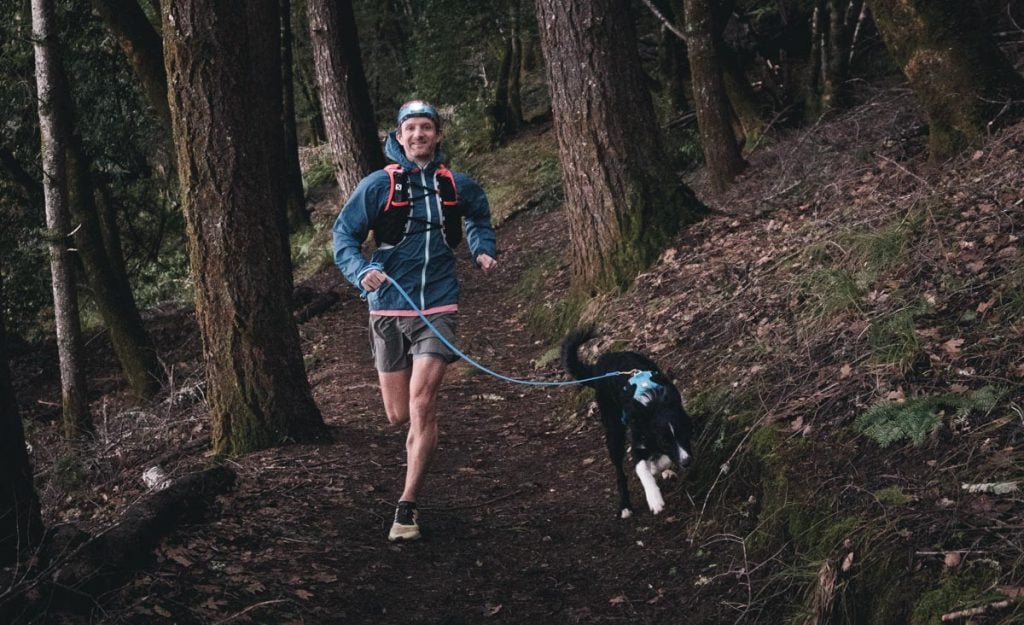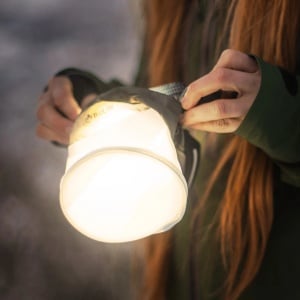Just when I thought high-quality headlamps couldn’t get any lighter, BioLite releases the ultra-lightweight USB rechargeable Headlamp 200. When I reviewed BioLite’s original headlamp, the HeadLamp 330, it was already the lightest, most comfortable, and reasonably priced headlamp we have tested but the HeadLamp 200 takes all these features/benefits to the next level.
There are certain situations though where a higher-powered headlamp, like the HeadLamp 330 (which also has a longer battery life) will be more suitable for runners or hikers, I’ll elaborate on that later in this BioLite HeadLamp 200 review. All in all though, if you’re looking for a very reasonably priced, lightweight headlamp for short to medium-distance night runs or hikes during the dark winter months then the HeadLamp 200 may be better suited to your needs.
Many headlamps need a large battery in order to create a high-power lumen output. These batteries are heavy though and will add extra weight to the front of the system, or in some cases the rear if that’s where the battery is stored. A battery pack towards the rear works well as a headlamp’s total weight can then be spread across the front and rear, as opposed to keeping it all at the front, which adversely allows for headlamp bounce as you run.
SIMILAR BIOLITE REVIEWS: BioLite HeadLamp 425 Review / BioLite HeadLamp 750 Review / BioLite HeadLamp 330 Review
The HeadLamp 330 has a pack towards the rear, and it works brilliantly, allowing for a much slimmer, lightweight light housing toward the front but the BioLite HeadLamp 200 improves on this by removing the battery housing from the rear completely and putting a much smaller battery towards the front in a very minimally combined light/battery housing.
The 200’s housing on the front is slightly larger than the HeadLamp 330 but still very small and light, in comparison to many other headlamps on the market. It’s also just as comfortable as the HeadLamp 330 and does not need to be worn over a hat or headband to stay comfortable and secure whilst running.
This BioLite HeadLamp 200 review runs through the key features of the HeadLamp 200, what I love/dislike, and how it performs while running and hiking (trail running and ultra running too).
Table of Contents:
- What’s the BioLite HeadLamp 200 like for running?
- How bright is the beam and is it easy to control?
- How comfortable is the BioLite HeadLamp 200?
- What’s the battery life like?
- Is the HeadLamp 200 waterproof?
- Where to buy the HeadLamp 200
- Image Gallery
- What are the key differences between the BioLite HeadLamp 200 and 330
- Do Headlamps make you feel nauseous? Here’s a solution.
What’s it like running with the BioLite HeadLamp 200?
Having a hyper-lightweight headlamp like the BioLite HeadLamp 200, which only weighs 50g, has its advantages, including extra comfort and zero bounce while running. A lightweight headlamp is also much more convenient to stow away and carry in your hydration pack while you’re not using it. The HeadLamp 200 has these benefits but due to its smaller battery, it’s not the best headlamp for ultrarunners who will be running for over 6 hours through the night. The battery will last around 3 hours with its brightest setting of 200 lumens and although there are other lighting modes including a LO beam which increases battery life to 40 hours, I wouldn’t recommend running trails with this setting as you will have a hard time seeing things like rocks, roots, and dips in the trails.
The headlamp can be easily adjusted by pulling the two plastic cinches on either side of the headband towards the front of your head to make it tighter, and towards the back of your head to make it looser.
How bright is the beam and is it easy to control?
The BioLite HeadLamp 200 has a beam that projects 200 lumens of light 50 meters ahead in a consistent circular fashion. You’ll also notice a softer floodlight that spreads wider than the main spot beam to a distance of meters, although not very bright, this helps illuminate nearer objects not directly in front of you. These two beams are in the same light mode the floodlight is the small light on the right side of the headlamp.
This mixture of beams means that you don’t have to be laser-focused on a small dot for your immediate path ahead while running, which can make some people feel nauseous.

To increase battery life while using the headlamp, once you have cycled to the beam you want, just press and hold the button again and the light will start dimming.
Keep holding it for the lowest setting or let go sooner to get a midway brightness level. The HeadLamp 200 will also remember the brightness level you set it at for the next time you turn it on, this is so helpful, especially when you’re out camping and don’t want to blind yourself or camp buddies by accidentally putting the headlamp into its brightest mode before your eyes have adjusted to the darkness.
There’s also a white strobe light mode, red light mode, and a red strobe light mode. on this headlamp. The red light is great for your night vision while doing tasks in the dark, other than running, and the strobe lights are great for getting someone’s attention during an emergency situation on the trails.
I really like how easy it is to use too, there’s one single button which is used to turn it on, cycle through the 4 beam modes and to lock the headlamp so you don’t accidentally turn it on while it’s in your hydration pack or while you’re traveling.

Having such a simple user interface makes it easy to use even during the winter months when winter running gloves are necessary to keep you warm. The HeadLamp 200 also has 4 levels of tilt positions to point the beam toward the ground more or less, depending on your speed and how far ahead of you would like to see.
How comfortable is the BioLite HeadLamp 200?
The HeadLamp 200 only weighs 50g (that’s nearly 20g less than the HeadLamp 330), which is insanely lightweight for a running headlamp. This makes the whole experience of running with a headlamp so much more enjoyable.
In the past, it wasn’t uncommon to get a headache from wearing a headlamp because you would be required to over-tighten the band in order to reduce the bounce, due to the weight of the battery on the front.
The BioLite HeadLamp 200 uses a moisture-wicking sweatband (pictured above), which keeps the sweat off your face while adding to the overall comfort of wearing the headlamp.
How long does the BioLite HeadLamp 200 Battery last?
The battery will last 3 hours in its brightest mode of 200 lumens, and 40hours in LO mode which you can activate by tapping the button once and then tapping again with a press and hold until the light dims to its lowest level of 5 lumens.
This means that the headlamp is perfect for most running or hiking situations, provided you’re not going to be out running through the entire night. You could probably hike with a reduced beam intensity as you’ll be moving at a slower speed but I wouldn’t recommend running with anything other than the high-beam for safety reasons unless of course you’re in survival mode and have no choice.
How do you know when to recharge the HeadLamp 200?
When you turn off the headlamp off, the floodlight (the little round light on the right) will flash to give you an indication of how much battery life you have left. Two green blinks and it’s more than 50% full, Two red blinks and it’s less than 50% full, and Four red blinks and your HeadLamp 200 is out of juice and needs a recharge.
The BioLite HeadLamp 200 uses a USB Rechargeable 700 mAh Lithium-Ion battery which uses a micro-USB cable and connector. It takes roughly 2.5 hours to fully charge. There’s no light on the rear of the HeadLamp 200 but BioLite has added a reflective strip on the rear of the band so that you’ll be seen by anyone who shines a light towards you (as seen in the photo above).
Having a 40-hour battery life option gives this headlamp so many more uses, for example, you can pair it with BioLite’s Light Diffusing Stuffsack to turn it into a lantern for camping with. Such a clever multi-use headlamp also makes it great for fast and light adventures like fastpacking for example.
Is the BioLite HeadLamp 200 waterproof?
The HeadLamp 200 is IPX4 rated which means it’s water-resistant and can be worn in the rain but BioLite doesn’t recommend using it for extended periods of time, in a downpour for example.
How much does the HeadLamp 200 cost?
The BioLite HeadLamp 200 costs $44.95 which I think is very reasonable for such a fully-featured, ultra-light headlamp like this, especially as there’s really not any competition for it in its class at the moment. The HeadLamp 330 has seen a price increase to $59.95 since the release of this new headlamp.
|
|
$49.99
1
new
from $49.99
|
See Deal |
|
|
$23.97
out of stock
|
See Deal |
|
|
$39.95
out of stock
|
See Deal |
|
|
$19.83
out of stock
|
See Deal |
BioLite HeadLamp 200 Image Gallery









What’s the difference between the BioLite HeadLamp 200 and HeadLamp 330?
- The HeadLamp 200 is much lighter than an already lightweight headlamp. HeadLamp 200 weighs 50g while the HeadLamp 330 weighs 69g. This is great for stowing it away while not running.
- Both headlamps are equally comfortable to run with. Even though the HeadLamp 330 is headier and has a battery pack at the rear, the clever weight distribution keeps it feeling very comfortable.
- Both have an adjustable sweat-wicking headband.
- The HeadLamp 330 has a brighter full-beam setting of 330 lumens. The HeadLamp 200 shines 200 lumens bright.
- The HeadLamp 330 battery lasts longer with a brighter beam (4 hours at 330 lumens). As opposed to 3 hours at 200 lumens).
- The HeadLamp 330 has a stand-alone floodlight mode. The HeadLamp 200 uses these two beams at the same time with no option to have one or the other.
- Both headlamps have a waterproof rating of IPX4.
- Both come in 4 different color options.
- Both have a lock function to stop you accidentally turning the torch on while traveling or scrambling through your bag.
- Both have a reflective strip on the back to stay visible to cars, or other people with a light shining toward you. Neither has a red light on the rear though.
[letsreview]
I hope you enjoyed reading this in-depth BioLite HeadLamp 200 review and if you have a question, please let me know in the comments below.
Do Headlamps make you feel nauseous? Here’s an alternative solution for running at night.
Some people really struggle with headlamps because they make them feel nauseous, no matter what headlamp they use. This has to do with the placement of the light source, which on a headlamp is just above your eyes. When light illuminates from the perspective you’re viewing from, shadows will be cast directly behind and raised objects. This can make the terrain tricky to read for some but there’s a solution!
The Kogalla RA! This light strip shines brighter than most headlamps, runs longer than a rechargeable headlamp, and covers a wide area like a camping lantern. If you’re going to be mixing up your adventures like camping, hiking, or running at night, the Kogalla RA is a great option! I love that each of Ra’s five lighting modules is as bright as a high-quality headlamp. But instead of lighting up a spot, Ra lights up an entire area, making it easier to navigate even the roughest of terrain.
With its magnetic fastening system, you can also get creative with how you attach the strip lights to your clothing or just strap it around your waist.







